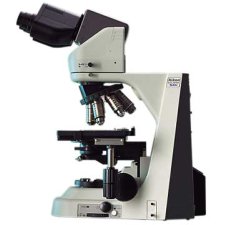Nikon Microscopes
Models Review: Optiphot, Labophot Eclipse 50i and E100
From the time the first Nikon compound monocular microscopes were produced in 1917, Nikon microscopes continued to evolve over the next seven decades; in the late 1970s and early 1980s, they introduced the Optiphot and Labophot models. Many labs and schools still choose to use these older, durable models.
Today, Nikon remains an industry leader in microscope innovation, with the popular Eclipse Series.
Nikon Optiphot Microscopes
Nikon came out with the first Optiphot microscope in the late 1970s, making improvements to this series until the Optiphot 2 in 1994.
With each improvement made to the Optiphot, Nikon strived to find a way for consumers to update older models.
Some basic features of the Optiphot are:
- HFX Microflex photomicrography system
- CF Optical system
- large rectangular, rotating mechanical stage
- 50w halogen Kohler lighting
The Optiphot is a durable multi-function confocal microscope that enables researchers to capture detailed images with the HFX camera. This built-in camera system combined Nikon’s innovations in photography and microscopy and took both to a new level.
The Optiphot is still used in many labs today; however, Nikon’s newer models, with the CFI60 optical system, capture far superior images than its HFX predecessor.
Nikon Labophot Microscopes
Released in the early 1980s, the Labophot is a sturdy, reliable and versatile, entry-level research microscope.
The Labophot microscope specifications include:
- mechanical, rotating stage (rectangular or circular)
- bright and dark field capabilities
- 6v-20w Kohler halogen lamp
- CF optical system, which increases image quality
- quick change filters
In addition, the Labophot can be equipped with a number of accessories for phase contrast, fluorescence and polarizing microscopy.
Many find this model attractive because of its durability and adaptability.
The Labophot can be used in a number of different settings, including clinical, biological, industrial and educational labs.
Although it does not have the capabilities of newer computerized models, it still holds it’s own as a relevant addition to any laboratory.
Nikon Eclipse Series
Nikon microscopes reached new heights with the introduction of the Eclipse series in the late 1990s.
These microscopes are impressive in their ergonomic design, image capabilities, versatility and use of technology and keep with Nikon’s tradition of manufacturing durable, versatile and adaptable products.
Common to models in this series are the following features:
- CFI60 optical system, which increases resolution, light and performance
- XY stage movement
- CAE (computer aided engineering)
- tilting eyepiece with diopter adjustments
- rotating, mechanical rectangular stage
In addition, the Eclipse Series enables bright field, dark field, epi-fluorescence, phase contrast and simple polarizing observations.
Eclipse 50i
 Nikon Eclipse 50i Microscope from
Nikon Eclipse 50i Microscope frommicron-optics.com
The Eclipse 50i is an upright Nikon microscope primarily used in clinical laboratories.
In addition to the abovementioned features, this model offers 10-1500x magnifications, a hardened finish to prevent scratches, easy access to controls, multi- filters and the ability to add accessories.
To really get a grasp on its features check out the Eclipse 55i. This model has the added bonus of using LED as a light source for cooler illumination but other that this feature, the 50i and 55i models are identical.
Eclipse 100
The Eclipse 100 is a popular model, ideal for educational and general clinical lab settings.
Nikon E100
It utilizes the CFI Infinity Optical System, which increases image contrast by decreasing chromatic and spherical aberrations.
The 6v-20w Halogen lamp is easily interchangeable with a Field Lens unit; it magnifies specimens from 40-1500x; and has a double-plated mechanical stage.
The E100 can be modified to meet specific needs with an array of accessories that allow features such as phase contrast and digital imaging.
The image capabilities of the basic Eclipse 100 microscope, coupled with the additional features and accessories provided, make this a popular choice for school and small labs.
Nikon microscopes have proven to be durable, long-lasting essentials in educational, industrial and clinical laboratories.
Nikon’s reputation for quality and cutting-edge advancement in microscopy is shown in the Optiphot, Labophot and Eclipse Series models.
The Optiphot and Labophot microscopes are still relevant and welcome additions to many labs, while the Eclipse Series has opened up new and amazing visual imaging systems in the realm of microscopy.
Reviewing other models from the Eclipse series is vital to assuring you find the best microscope from Nikon to suit your purposes. Take a look at the Eclipse 55i and E200 also.
The E200 is the sister microscope to the E100 but was the first educational/clinical microscope to have the CFI60 optical system and equipped with eyepieces with a wider field of view for an educational level scope.
Nikon's accessory interchangeability is a vital point to keep in mind when making a microscope purchase. Your lab will save considerable money for the long term.
Official website: Nikon.com
Return from Nikon Microscopes to Compound Light Microscopes
Return to Nikon Microscopes Reviews
Return to Best Microscope Reviews Home
Find out how to advertise on MicroscopeMaster!




